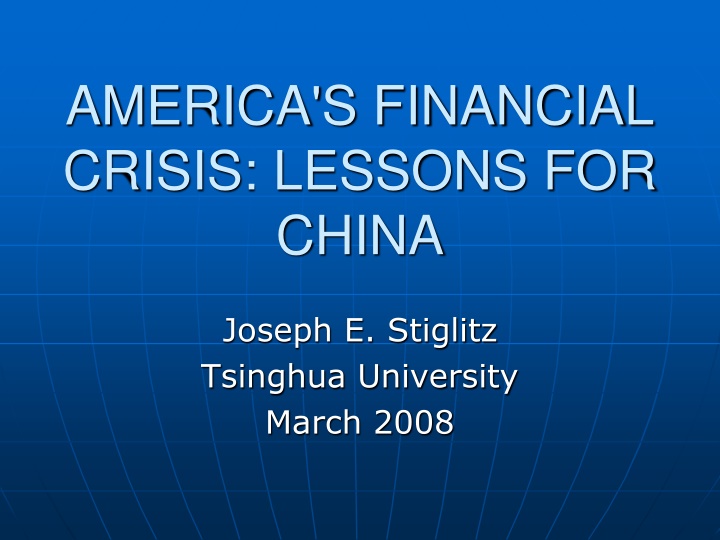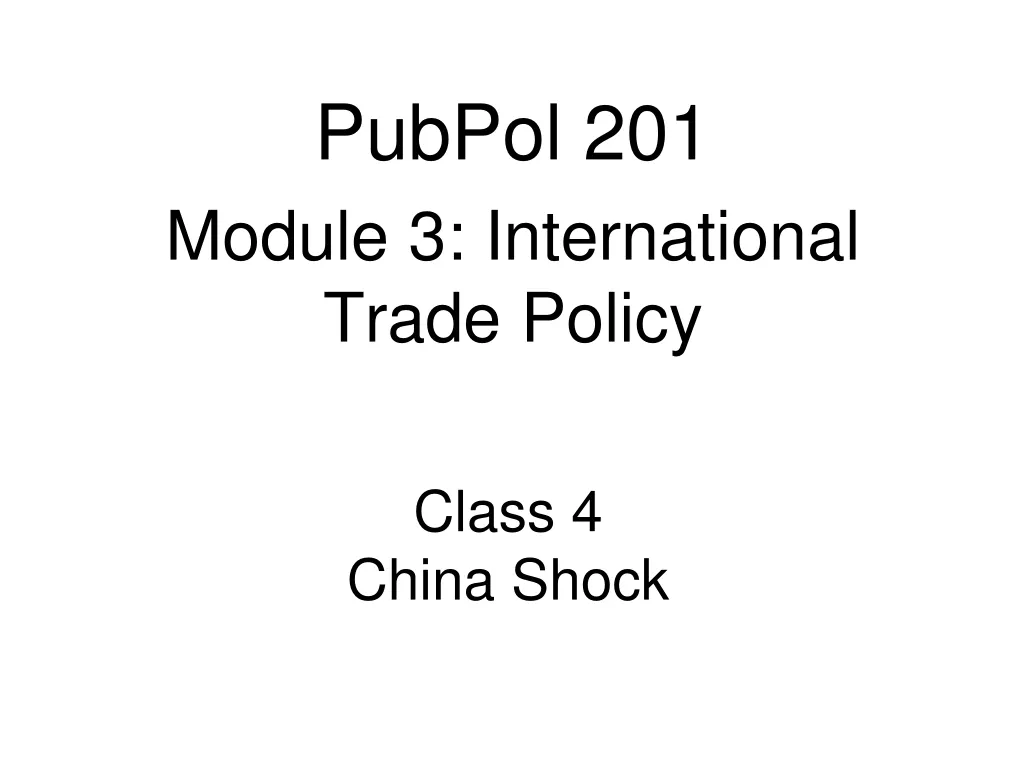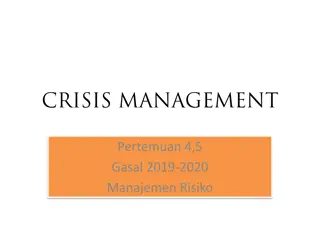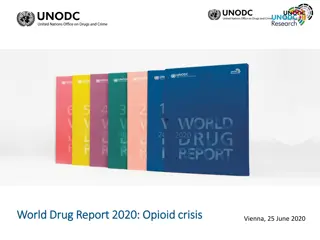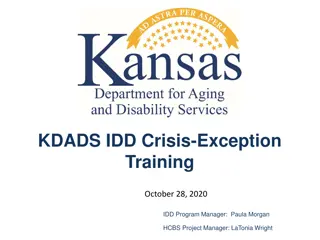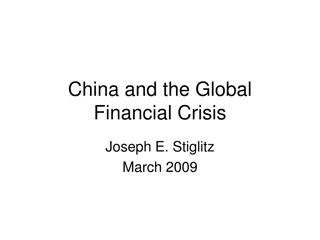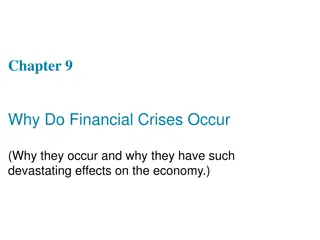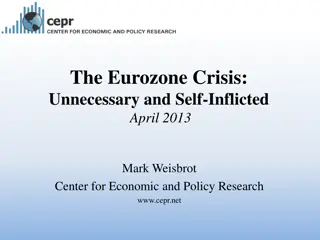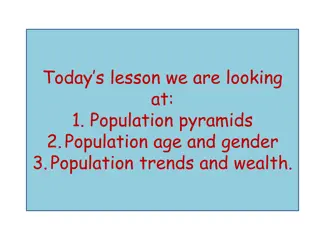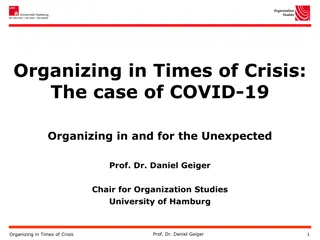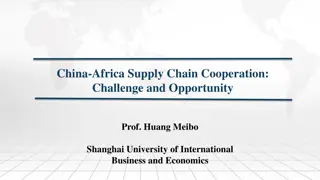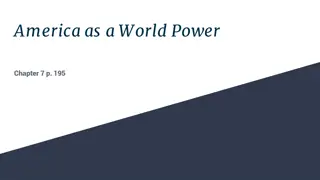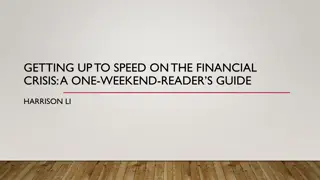Lessons from America's Financial Crisis for China
Market economies are not self-regulating and prone to excesses, with inadequate regulatory structures having deep and lasting consequences. Ideologies can impede problem resolution, leading to social injustice. The global consequences of inadequate regulations in the U.S. have impacted foreign financial systems. The slowdown in the U.S. will have global implications, and flawed proposals for bank regulation pose risks.
Download Presentation

Please find below an Image/Link to download the presentation.
The content on the website is provided AS IS for your information and personal use only. It may not be sold, licensed, or shared on other websites without obtaining consent from the author.If you encounter any issues during the download, it is possible that the publisher has removed the file from their server.
You are allowed to download the files provided on this website for personal or commercial use, subject to the condition that they are used lawfully. All files are the property of their respective owners.
The content on the website is provided AS IS for your information and personal use only. It may not be sold, licensed, or shared on other websites without obtaining consent from the author.
E N D
Presentation Transcript
AMERICA'S FINANCIAL CRISIS: LESSONS FOR CHINA Joseph E. Stiglitz Tsinghua University March 2008
Profound Lessons Concerning Market Economies Market economies are not self- regulating Prone to excesses With many people suffering in process Market fundamentalism has no theoretical or empirical foundations And the belief in market fundamentalism can be very costly
Inadequate regulatory structures can have deep and long lasting economic and social consequences Notion that regulators could rely on banks own risk management systems and rating agencies was questionable Products that were supposed to mitigate risk increased it If those who were supposed to know about managing risk could do such a bad job, what about those who were not professionals?
Ideology can not only cause problems, but can impede in their resolution Once again, the rich and well-off are being bailed out, but the poor are being left to manage on their own Contributing to America s growing inequality and sense of social injustice
Global consequences Inadequate regulations in U.S. But foreign regulators trusted U.S. U.S. allowed to export its toxic financial products abroad Causing weakness in foreign financial systems Mitigating impact in US of bad behavior and bad policies US icons bailed out by sovereign wealth funds
Slowdown in US will have global consequences US still largest economy in world No such thing as decoupling Though effects may be reduced by new sources of growth But US is exporting its downturn Similar to beggar thy neighbor policies of Great Depression But this time through competitive devaluation
Flawed Proposal to Strengthen Bank Regulation Basle II relies on risk management systems of major banks and risk assessments of rating agencies Both have been shown to be highly flawed Both seemed to have believed in financial alchemy Securitization converted low-grade loans into AAA rated financial products Ultimate example of market fundamentalism: relying on market to regulate itself
Failures Failure to understand correlated risks And how banks, using similar models, can give rise to correlated risks Failure to understand systemic risk has systemic consequences Including risks facing market insurers Failure to understand fat-tailed distributions With once in a hundred years events occurring every decade!
Failures Failure to understand the economics of securitization Understood advantages of diversification Failed to understand problems of information asymmetries associated with securitization Including possibilities of bad actors , i.e., distorted appraisals Failed to understand problems of re-negotiation Contrast with old model where banks originated loans, kept them, and re-negotiated if necessary
Intellectual incoherence Thought new products were creating a new world, yet used data from earlier periods to assess risk Ultimate refutation of rational expectations Problems had been pointed out earlier And some were seen in earlier crises
A Closer Look at the Current Problem Three distinct but related problems: The freezing of credit markets The sub-prime mortgage crisis The impending recession Each teaching lessons about economics Even well-functioning market economies have problems Monetary and regulatory authorities in U.S. made major mistakes Each interacting to exacerbate problem
The Sub-Prime Mortgage Crisis Loans were made to people who couldn t afford them With negative amortization And reset provisions Pyramid scheme borrowers were told not to worry, home prices would continue to rise, they could refinance (with large transaction costs) The more you borrowed, the more you made
Foul Play Lobbyists worked hard to prevent legislation intended to restrict predatory lending New bankruptcy legislation gave lenders confidence that they could squeeze borrowers Over-valuation of residential real estate
Bad Advice and Complicity of Regulators Fed encouraged people to take out variable rate mortgages just as interest rates reached lows Part of strategy to keep the economy going Especially important in light of high oil prices And drag on economy from the Iraq War Encouraged reckless lending Said that it would lead to more home ownership Real result is just the opposite more foreclosures Should have recognized that there was something wrong gong on Some mortgages were made with no money down With borrowers able to walk away, like giving away money But normally, banks do not give away money
What were They Thinking? Unprecedented increase in housing prices Obviously was not sustainable Especially as median real income in the U.S. was declining Housing prices have already fallen 10%, likely 20% further decline 2.2 million Americans likely to lose home in next year But with decline in housing prices 14 million Americans will have mortgages exceeding house value
The Credit Crunch Products were so complicated that neither originators nor borrowers nor regulators could adequately measure the risk Clearly not designing products to meet specific risks Lack of transparency may have been biggest culprit Lack of transparency is what is giving rise to the credit crunch Irony given criticism from US concerning lack of transparency in Asia It is clear that the losses are far greater than those revealed so far
The Problem is Huge More than 2 million anticipated foreclosures Many will lose their entire life savings Foreclosures will lead to falling home prices Large real adjustment needed Vicious circle May well extend beyond sub-prime mortgages Problem is not just lack of liquidity, many individuals cannot afford housing Unless something is done, there will be huge dislocations, as people downsize, house prices get reappraised with large transactions costs, and everybody loses
What was going on? Regulatory arbitrage Accounting management la Enron? (off/on balance sheet arbitrage) Flawed incentive structures With securitization, mortgage brokers got their money up front Hedge fund incentive structures encourage excessive risk taking Rating agencies paid by those producing bad products Regulators drawn from investment community had incentive to keep the party going
Impending Recession Growing consensus among economists that there will be a substantial gap between actual and potential GDP Even a 2% shortfall for one year means a loss of a quarter of a trillion dollars Conservative estimate of cumulative loss to U.S.--$1.5 trillion This is worst downturn in at least quarter century, probably since Great Depression Most have been inventory cycles, or Fed stepping on brakes too strongly to stop inflation no major structural problem 1991 downturn related to S & L s, small part of financial system
Underlying Macroeconomic Problem The US economy has been fueled by unsustainable consumption for the past five years: Zero or negative savings for the last two years Based on optimism from rising home prices And persistence of low interest rates Financed through home equity withdrawals in the hundreds of billions of dollars Much of it from sub-prime borrowers
A Cover-Up? High level of liquidity, regulatory laxness required to offset earlier policy mistakes Iraq war led to rising oil prices Rising oil prices meant that hundreds of billions of dollars were being spent to buy oil rather than to buy American made goods Iraq expenditures did not stimulate economy in the way that other expenditures might have 2001-2003 tax cuts were not designed to stimulate the economy, and did so only to a limited extent Question: Why did the economy seem as strong as it did? Answer: America was living on borrowed money and borrowed time There had to be a day of reckoning That day has now arrived
The Game is Over Households will not want or be able to continue taking out more money from their homes Housing prices down 7% from peak New regulations Closing the barn door after the cows are out May have adverse short-run effects (the standard trade-off) Securitization game which started it all is also over Increased scrutiny on valuations Increased scrutiny on rating agencies Increased scrutiny on CDO s and other instruments If savings returns to normal rate of 4 to 6%, it will create a major drag on aggregate demand If adjustment is quick, downturn may be deep If adjustment is slow, downturn may be prolonged
What will Replace Consumption? Probably not investment Net exports have so far played an important role But unlikely to be sufficient And will have global ramifications Can government action save the day? Given lags, it may already be too late
Can Monetary Policy do the Trick? Probably not Keynes view: pushing on a string Will lenders be willing to lend, and households be willing to borrow, to continue unsustainable consumption? Probably not And this would just be postponing the day of reckoning Making eventual adjustments even more difficult In politics, timing is everything Long-term interest rates may even increase as inflationary expectations mount They didn t rise as short term rates rose ( conundrum ) This is just the reverse
Flawed Fed Strategy Is preventing a rapid melt-down But is creating reinforcing moral hazard problem There was an alternative Put quarter of billion dollars paid to Bear Stearns shareholders in escrow, to be used if problems are as bad as market believes they are Tax payers should not be asked to pay out anything so long as Bear Stearns shareholders walk away with anything And their shareholders should be charged an insurance premium Unconscionable give-away
Fiscal Stimulus? Any stimulus should be timely and targeted to maximize impact (especially important given high level of U.S. deficit), and address long-term problems Most effective excluded from package Unemployment insurance America probably has worst unemployment insurance system of advanced industrial countries Assistance to states and localities Tax revenues about to plummet Forcing them to cut back on spending Leading to deepened downturn
Other Features of Stimulus Tax rebates May be less effective than normal: uncertainty may lead many to use refunds to pay credit card bills, etc. Exacerbates fundamental problem excessive consumption Business incentives Mostly for investment that would have occurred anyway Very low bang for the buck
What Else Should Have Been Done? Marginal investment tax credit strong incentives for additional investment Infrastructure investment America s infrastructure is in bad shape Not a single one of the top ten global airports is in U.S. Not enough public transportation Other green investments necessary to achieve global warming targets R & D Public R & D has high return on investment Underlies America s economic strength Cut backs in recent years Strategies that stimulate in the short-run while providing basis for long-run growth What China did in 1997/1998 crisis
Should begin at the bottomthe source of the problem, the large number of households who will lose their homes A home-owners Super chapter 11 Write down mortgages to 80/90% of current market value Homeownership assistance for poor we already give it to rich through tax system Government program to purchase foreclosed homes, prevent community blight
Sovereign Wealth Funds Not a surprise that they had to rescue America s premier financial institutions Large redistribution of global (liquid) wealth America has not been saving America has become consumer of last resort, living beyond its means High oil prices have created huge reserves of liquid funds in the Middle East Mismanagement of 1997-98 crisis has led developing countries to say never again will they allow loss of economic sovereignty To prevent history from repeating, they have accumulated massive reserves
Worries about Sovereign Wealth Funds Partially reflect old-fashioned protectionist sentiment Partially reflect worries about inadequacy of our regulatory structures Both competition (can a firm be so large that its actions become relevant ?) And regulations concerning conduct Though most of the potential problems could arise with any form of private ownership, whether foreign or domestic
G-7 Solutions Not Well Thought Out Transparency Fashion of the day Cure-all for all problems Part of long-standing strategy of diverting attention (used in 1997-98 crisis) But what information would guarantee that they behave well ? So long as there are unregulated, secret hedge funds, they could always buy ownership through hedge funds
New regulatory structures NOT sufficient to rely on self- regulation More transparency Reducing scope for conflicts of interests Repeal of Glass Steagall was a mistake Exacerbated conflicts of interest Evidenced in Enron, Worldcom And extended government bail-outs Bear Stearns unprecedented But this is not enough
Regulating incentives At least when it comes to those dealing with regulated institutions (banks, fiduciaries) Consumer product safety commission What risks are products supposed to manage? Are the products safe ? Do they do what they are supposed to do? Presumption that there is no such thing as a free lunch Attention to regulatory capture Financial Markets Regulatory Commission Need to look at markets as a whole
Global Financial Integration The world has become increasingly integrated Implying that there is more interdependence Problems in one part of the global economic system have ramifications for the entire system Implying that there is more need for global collective action
Need for Global Collective Action But we have neither the institutions, nor the mindsets, with which to do this effectively, and democratically There is greater need for institutions, like the IMF, to regulate the global international financial markets But confidence in these institutions has never been lower Failed to do anything about global imbalances Failed to do anything about inadequate regulations Flawed proposal to strengthen bank regulation
Global Imbalances Massive U.S. borrowing from abroad $850 billion in 2006 alone U.S. blames China (undervalued yuan) But even if China revalued its currency and completely eliminated its trade surplus, and even if China s surplus translated dollar-for-dollar into a reduction of U.S. trade deficit, the U.S. trade deficit would still be massive, reduced to only $720 billion More likely scenario is that the deficit would be little changed, as U.S. buys textiles from Bangladesh and other countries US simply trying to shift blame Genuine worry is potential disorderly unwinding
Making Globalization Work Failure of IMF not a surprise U.S. major source of global imbalances Inadequate regulation in U.S. having global consequences But U.S. has veto power at the IMF IMF not likely to be aggressive in criticizing U.S. Contributes to undermining credibility of IMF
Other Institutions Also Not Working G-8 most important informal institution Major issues: Global imbalances Blame China, but China is not there Sovereign Wealth Funds But sovereign funds are not there Global warming Blame developing countries But developing countries are not there Not good enough just to invite them to lunch Without consulting on agenda or communique Especially when communique is issued before lunch
Need Better Cooperation in Global Financial Markets Macroeconomic cooperation Cooperation on regulation But voices of developing countries have to be heard Reform institutions Reform governance Will need some more fundamental reforms
Fundamental Reforms After 1997-98 global financial crisis, discussion of fundamental reform in global financial architecture Nothing came of it Consistent with suspicions at time that U.S. did not want any change What kinds of policies exacerbate contagion, contribute to automatic destabilizers ? Many of IMF and banking regulatory policies may contribute to instability
Fundamental Reforms Developing countries still bear brunt of interest and exchange rate risk International institutions should bear larger share of risk No mechanism for restructuring sovereign debt Global reserve system
Global Reserve System Dollar-based system is fraying US has been consumer of last resort US has been debtor of last resort Contributes to instability and cannot work in the long-run As dollar debts accumulate, confidence in dollar erodes Inequitable Developing countries lending U.S. huge amounts of money at low interest rates Net transfer to U.S. is greater than foreign aid U.S. gives to developing countries Dual (dollar/euro) reserve system may be even more unstable
We CAN make globalization work Or at least work much better Both for the developing and the developed world
But if we are to do this We have to learn the lessons of the current economic crisis Market fundamentalism does not work Need to have good regulatory structures We have to have fundamental reforms in the governance of the global economic system
